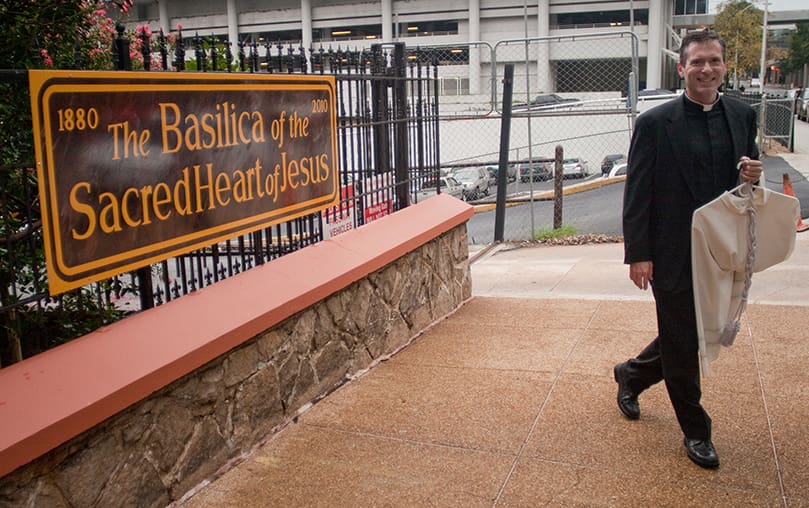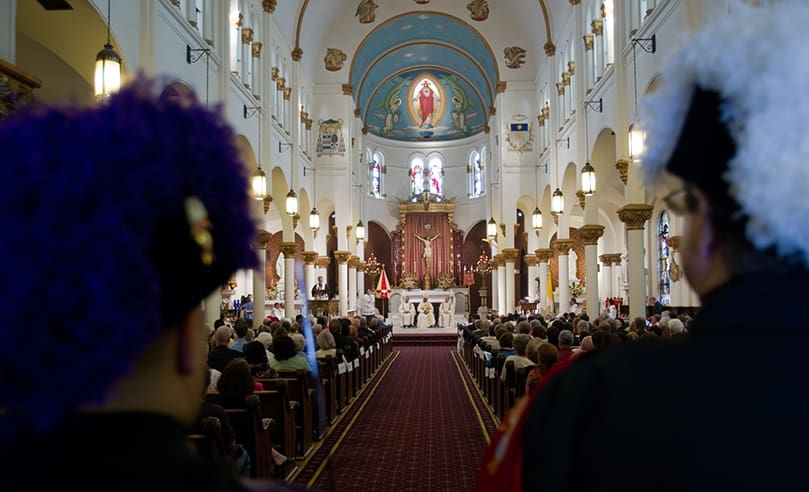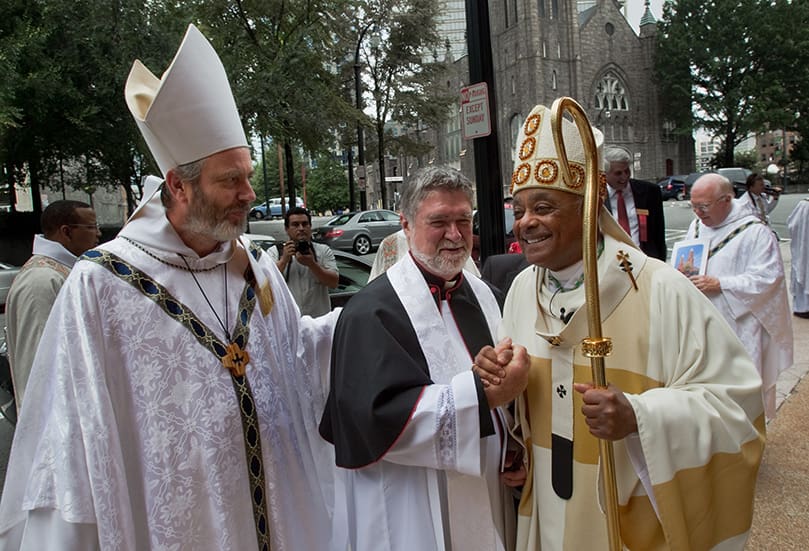Father Luke R. Ballman, director of vocations for the Archdiocese of Atlanta, walks past the new sign in front of Sacred Heart. Photo by Thomas Spink
Atlanta
Sacred Heart Elevated To Basilica In Joyous Mass
By STEPHEN O'KANE, Staff Writer | Published September 2, 2010
The ringing of the new tintinnabulum marked the beginning of a joyous celebration of the Eucharist on Saturday, Aug. 21, honoring the elevation of Sacred Heart Church to the status of minor basilica, the only church in Georgia to hold the title.
Archbishop Wilton D. Gregory entered the packed sanctuary following an ornate procession of clergy, including deacons, more than 30 priests, pastor Father T.J. Meehan, Atlanta Auxiliary Bishop Luis Zarama and Archbishop-emeritus John F. Donoghue.
“Today, we gather in this church of the Sacred Heart of Jesus to commemorate its designation as a basilica—a special church in its relationship to the See of Peter,” said the archbishop.
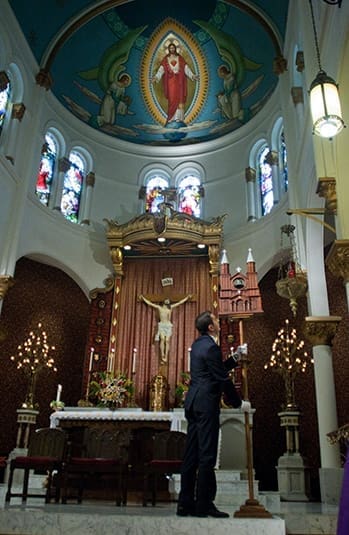
David Castronovo puts the tintinnabulum in its rightful place on the altar. The tintinnabulum, a bell on a pole, signifies the church’s link with the Pope. It’s one of two symbols on display at a basilica. The other is the ombrellino, an elaborate umbrella always displayed halfway open to signify the church is ready to welcome the Holy Father. Photo by Thomas Spink
Carried in with the procession was the tintinnabulum, a bell mounted on a pole and something that appears in every Catholic basilica as a symbol of the church’s link with the pope, as well as the ombrellino, or “little umbrella” that serves as a symbol of the authority of the pope.
The tintinnabulum for the Sacred Heart Basilica is a carved wooden image of the front façade of the building with the bell placed in the spot of the church’s rose window. The ombrellino canopy was stitched and fitted by Sacred Heart parishioner Carmen Gaffney, and has eight panels with symbols of the church’s history, including the crest of the Archdiocese of Atlanta, the crest of Pope Benedict XVI and the crest of Archbishop Gregory.
The ombrellino also features the crest of the Basilica of the Sacred Heart of Jesus, a crest designed at the time of the announcement of elevation. The crest features a gold scallop shell, the archdiocesan crest, the symbol of the Marist community and an image of the Sacred Heart of Jesus.
After the procession, Msgr. Stephen Churchwell, who is in residence at the basilica, read the apostolic letter, which announced the elevation of Sacred Heart. It was met with a hearty round of applause.
To be named a minor basilica, a church must meet certain criteria. According to Domus Ecclesiae, a document that contains the conditions for an elevation, the church “must have been dedicated to God by a liturgical rite and must stand out as a center of active and pastoral liturgy, especially through celebrations of the Most Holy Eucharist, of penance, and of the other sacraments, which celebrations set an example for others on account of their preparation and realization according to liturgical norms and with the active participation of the people of God.”
The document also states that “the church may enjoy a certain renown throughout the diocese,” and “the historical value or importance of the church and the worthiness of its art are also be considered.”
During his homily, Archbishop Gregory highlighted the importance of the Sacred Heart community in the history of the city of Atlanta and the state of Georgia.
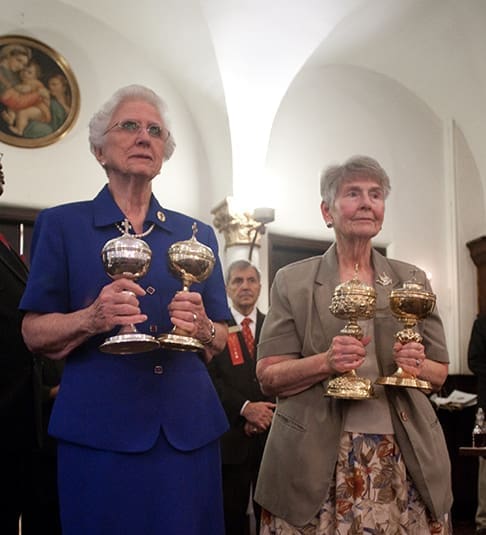
Sister of Mercy Valentina Sheridan, left, and Sister of Saint Joseph of Carondelet Louise Sommer bring the gifts forward during the offertory procession. Photo by Thomas Spink
“Sacred Heart is not the oldest parish community in the Archdiocese of Atlanta; that honor belongs to St. Joseph’s Parish in Washington, Georgia. Sacred Heart is not the oldest Catholic church building in the city of Atlanta; that honor belongs to the Shrine of the Immaculate Conception down the street. Neither is it the largest or the newest or the most elaborate or expensive,” said the archbishop.
“Sacred Heart does, however, enjoy a place of honor because its history is so interwoven with the history of Catholics in the entire state of Georgia,” he continued. “So many Catholics have passed through its annals, so many parishes are daughter communities from this Sacred Heart community, so many clergy and religious—especially our Marist Brothers—have a heritage within this parish that, in a real sense, to honor Sacred Heart Church is to honor the great legacy of faith that belongs to the Archdiocese of Atlanta and before it to the Diocese of Savannah.”
With a history of 130 years, it is expected that the Basilica of the Sacred Heart of Jesus would have a rich and interesting background. It all began on Feb. 28, 1880, when Bishop William Gross of Savannah inaugurated the parish of Sts. Peter and Paul, which would eventually come to be known as Sacred Heart. Only the second parish in the city of Atlanta, the original cost of the land on the east side of Marietta Street was $6,000 and the total expenditure for construction of the new building was $2,700. It originally seated 300 people.
In 1897, Savannah Bishop Thomas Becker gave the Society of Mary the commission to operate the parish with the understanding that the new operators would build and staff a new church. As the community continued to grow, a piece of land was purchased on Ivy Street at its intersection with Peachtree Street.
On May 1, 1898, Bishop Becker dedicated the new church, designed by architect Walter Downing, which cost an estimated $28,000. Its name was formally changed to the Sacred Heart of Jesus, a name approved by the bishop since the first Marist pastor had arrived on the first Friday of June 1897 and first Fridays are designated in particular for devotion to the Sacred Heart.
By 1910, the congregation had tripled to serve more than 1,200 people. Many changes had already taken place at that time, including installing a brass baptismal font and sanctuary kneelers and 28 stained glass windows. The choir and organ gallery had also been constructed.
The original Marist School opened on the property in 1901 as a high school and college for boys. It remained that way until the school moved to its current location on Ashford Dunwoody Road in 1962. A few years after the Marist School was built, the Sisters of St. Joseph opened the Sacred Heart School, which served grades one through six until it closed in 1964. Sacred Heart Girls School was opened in 1913 but closed in 1958 when St. Pius X High School opened as a co-ed school. A new high school, St. Pius Annex, was opened in 1960 in the former Sacred Heart School buildings. It later became St. Joseph’s High School but was closed in 1976, bringing an end to Sacred Heart’s affiliation with schools.
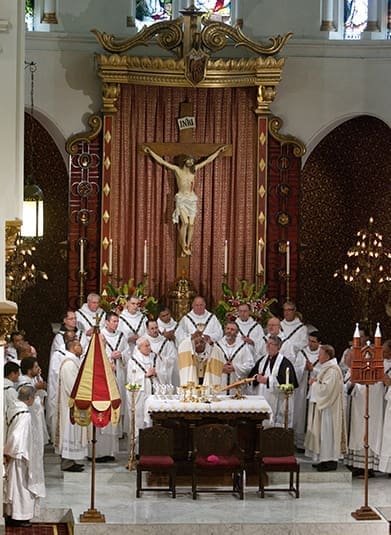
Book-ended between the newly installed Basilica symbols, Archbishop Wilton D. Gregory, center, and other clergy gather on the altar during the Aug. 21 Mass marking the elevation of Sacred Heart to a minor basilica. Photo by Thomas Spink
The most recent renovation came in 1987 when Father Daniel O’Connor refreshed the color palette of the church’s interior. In addition, the wall covering was changed, more lighting was added and gold leaf accents were applied to the columns, the arch and the ribs of the vaulted ceiling.
However, as Archbishop Gregory pointed out during his homily, there is more to a church than the physical building, however remarkable.
“Becoming a basilica is an honor that cannot merely be limited to the brick and mortar of a building, but to the faith of the people who built, used, sustained and hold this place to be a sacred site,” said the archbishop.
“Churches of all types provide the normal place where the Eucharist is both celebrated and where it is reserved,” he said. “They are the places where we meet God most frequently and where God chooses to reside and to wait for us to come to him. Some churches have been the places where God encounters his people for many decades—others are much newer, some are traditional in design and others quite modern, some have become famous for their hospitality and welcome and accessibility. All churches, no matter how humble, or elaborate or modest, are the sites wherein we meet God.”
At the end of the Mass, Father Meehan expressed his gratitude for the support of the parishioners and all those who have aided the parish throughout its long and rich history.
“On behalf of the wonderful people of this great parish, I want to thank you for your attendance and your prayers,” said Father Meehan. “I am especially thankful to Archbishop Gregory for his kind words today. … On this occasion of our 130th anniversary as a parish, we’re certainly mindful of the dedicated service of 26 previous pastors at this church.”
“We particularly acknowledge the long, loving service of the Marist community and the Sisters of St. Joseph of Carondelet. … It is so good to see the religious women of our diocese present for this celebration today,” he added.

Pots of flowers adorn the entrance of Sacred Heart Basilica, Atlanta, where a new symbol was placed above its doors to mark the historic building’s elevation to a minor basilica. Photo by Thomas Spink
The elevation of this special place of faith was recognized by civic leaders as well, including Gov. Sonny Perdue, who wrote a letter to the parish community to congratulate them, and Atlanta Mayor Kasim Reed.
“As the second oldest Catholic Church in Atlanta, Sacred Heart has enjoyed a long and proud tradition of service as a diverse community of faith, social outreach and ministry,” wrote Gov. Perdue. “Parishioners represent all walks of life and contribute greatly to the enrichment of the downtown Atlanta area.”
“Since its inception in 1880, Sacred Heart Catholic Church has been a pillar of faith within our community,” Mayor Reed wrote. “The many programs and outreach ministries that you continue to establish allow our residents to be blessed through your civic leadership. Your dedication to serve others and gather in fellowship demonstrates the rich spiritual heritage that is rooted in this church.”
“As we praise God today for his goodness and fidelity, let us also renew our own promises to live our Catholic faith with such intensity and pride that today’s ceremony becomes for us all a great moment where our history meets and guarantees our tomorrow,” said the archbishop.
